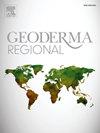无机肥料和有机肥料相结合改善了肯尼亚上东部地区的土壤微生物生物量和氮的动态变化
IF 3.3
2区 农林科学
Q2 SOIL SCIENCE
引用次数: 0
摘要
土壤微生物的生物量元素和矿化过程对补充土壤养分至关重要。然而,施肥对微生物的影响仍不十分明确。本研究旨在通过田间试验确定综合土壤肥力投入(无机和有机)对微生物生物量、碳(MBC)、氮(MBN)、磷(MBP)、氮(N)矿化和氮利用效率的影响。试验采用随机区组设计,处理包括:对照(无肥料投入)、单一无机肥料以及无机和有机肥料的不同组合。结果表明,与对照(CT0)相比,常规耕作+玉米秸秆+山羊粪+马铃薯(Dolichos lablab)间作(CT4);少耕作+玉米秸秆+Tithonia diversifolia+山羊粪(MT5);以及少耕作+玉米秸秆+山羊粪+马铃薯(Dolichos lablab)间作(MT4)分别提高了微生物C、N和P的78%、48%和41%。与 CT0 相比,在 2020 年的短雨季,各处理在播种时、播种后第 15 天、第 30 天、第 45 天和第 60 天的氮矿化度差异显著(p = 0.0001)。在 2021 年长雨季期间,相对于 CT0,各处理在种植后第 45、60、75、90 和 105 天的矿化度也存在显著差异(p = 0.0018、0.0028、< 0.0001 和 0.0028)。CT4 的表观氮回收率和部分系数生产率分别比 CT0 高 5.11 和 52.80 千克/公顷。同样,与 CT0 相比,MT4 的氮表观回收率提高了 57.5%。因此,应将整合有机肥投入(无论是单独使用还是与无机肥料一起使用)的技术作为中长期技术加以利用和推广,以提高小农的土壤生物肥力、矿质氮和氮的利用效率。本文章由计算机程序翻译,如有差异,请以英文原文为准。
Combined inorganic and organic fertilizers improved soil microbial biomass and nitrogen dynamics in Upper Eastern region of Kenya
Soil microbial biomass elements and mineralization processes are essential in replenishing soil nutrients. Yet, the effect of fertilization on the microbes is still not well-defined. This study aimed to determine the effect of integrated soil fertility inputs (inorganic and organic) on microbial biomass, carbon (MBC), nitrogen (MBN), phosphorus (MBP), nitrogen (N) mineralization, and N use efficiency in a field experiment. The treatments were: control (no fertility input), sole inorganic fertilizer, and different combinations of inorganic and organic inputs in a randomized block design. The results showed that Conventional tillage + maize residue + goat manure + Dolichos lablab intercrop (CT4); minimum tillage + maize residue + Tithonia diversifolia + goat manure (MT5); and minimum tillage + maize residue + goat manure + Dolichos lablab (MT4) intercrop increased microbial C, N, and P by 78 %, 48 %, and 41 %, respectively compared to control (CT0). Compared to CT0, N mineralization significantly varied (p < 0.0001) among the treatments at planting and on the 15th, 30th, 45th, and 60th days after planting during the 2020 short rains season. It also differed significantly (p = 0.0018, 0.0028, < 0.0001, and 0.0028,) on the 45th, 60th, 75th, 90th, and 105th days, respectively, relative to CT0 after planting during the 2021 long rains season. The CT4 had 5.11 and 52.80 kg N ha−1 higher apparent nitrogen recovery and partial factor productivity N, respectively. Similarly, MT4 greatly enhanced N apparent recovery efficiency by 57.5 % relative to CT0. Integrating fertility inputs improved soil biological fertility and mineralized N. Therefore, technologies that integrate organic inputs, either solely or with inorganic fertilizers, should be harnessed and promoted as medium and long-term technologies to advance soil biological fertility, and mineral N and N use efficiency in smallholder farmers.
求助全文
通过发布文献求助,成功后即可免费获取论文全文。
去求助
来源期刊

Geoderma Regional
Agricultural and Biological Sciences-Soil Science
CiteScore
6.10
自引率
7.30%
发文量
122
审稿时长
76 days
期刊介绍:
Global issues require studies and solutions on national and regional levels. Geoderma Regional focuses on studies that increase understanding and advance our scientific knowledge of soils in all regions of the world. The journal embraces every aspect of soil science and welcomes reviews of regional progress.
 求助内容:
求助内容: 应助结果提醒方式:
应助结果提醒方式:


